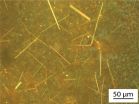Now a research team led by investigators in the Cancer Research Institute at Beth Israel Deaconess Medical Center (BIDMC), has identified an inhibitor of the Pin1 enzyme that can address both of these challenges in acute promyelocytic leukemia (APL) and triple negative breast cancer.
Their surprising discovery demonstrates that the vitamin A derivative ATRA (all-trans retinoic acid), a treatment for APL that is considered to be the first example of modern targeted cancer therapy, can block multiple cancer-driving pathways and, at the same time, eliminate cancer stem cells by degrading the Pin1 enzyme. Reported online today in Nature Medicine, these novel findings suggest a promising new way to fight cancer - particularly cancers that are aggressive or drug resistant.
"Pin1 changes protein shape through proline-directed phosphorylation, which is a major control mechanism for disease," explains co-senior author Kun Ping Lu, MD, PhD, Director of Translational Therapeutics in the Cancer Research Institute at BIDMC and Professor of Medicine at Harvard Medical School who co-discovered the enzyme in 1996. "Pin1 is a common key regulator in many types of cancer, and as a result, can control over 50 oncogenes and tumor suppressors, many of which are known to also control cancer stem cells."
Until now, agents that inhibit Pin1 have been developed mainly through rational drug design. Although these inhibitors have proven to be active against Pin1 in the test tube, when they are tested in vitro in a cell model or in vivo in a living animal they are unable to efficiently enter cells to successfully inhibit Pin1 function.
In this new work, co-senior author Xiao Zhen Zhou, MD, an investigator in BIDMC's Division of Translational Therapeutics and Assistant Professor at Harvard Medical School, decided to take a different approach to identify Pin1 inhibitors: She developed a mechanism-based high throughput screen to identify compounds that were targeting active Pin1.
"We had previously identified Pin1 substrate-mimicking peptide inhibitors," explains Zhou. "We therefore used these as a probe in a competition binding assay and screened approximately 8,200 chemical compounds, including both approved drugs and other known bioactive compounds." To increase screening success, Zhou chose a probe that specifically binds to the Pin1 enzyme active site very tightly, an approach that is not commonly used for this kind of screen.
"Initially, it appeared that the screening results had no positive hits, so we had to manually sift through them looking for the one that would bind to Pin1. We eventually spotted cis retinoic acid, which has the same chemical formula as all-trans retinoic acid [ATRA], but with a different chemical structure." It turned out, Zhou explains, that Pin1 prefers binding to ATRA and cis retinoic acid needs to convert ATRA in order to bind Pin1.
ATRA was first discovered for the treatment of acute promyelocytic leukemia (APL) in 1987. "Before tamoxifen or other targeted drugs, there was ATRA," says Lu. It was originally thought that ATRA was successfully treating APL by inducing cell differentiation, causing cancer cells to change into normal cells by activating the cellular retinoic acid receptors. But as these new findings reveal, although this differentiation activity is obvious, it is not the mechanism that is actually behind ATRA's successful outcomes in treating APL.
"While it has been previously shown that ATRA's ability to degrade the leukemia-causing fusion oncogene PML-RAR causes ATRA to stop the leukemia stem cells that drive APL, the underlying mechanism has remained elusive," says Lu. "Our new high throughput drug screening has revealed the ATRA drug target, unexpectedly showing that ATRA directly binds, inhibits and ultimately degrades active Pin1 selectively in cancer cells. The Pin1-ATRA complex structure suggests that ATRA is trapped in the Pin1 active site by mimicking an unreleasable enzyme substrate. Importantly, ATRA-induced Pin1 ablation degrades the fusion oncogene PML-RAR and treats APL in cell and animal models as well as in human patients.
"APL develops when two tumor suppressors fuse together to become an oncogene," adds co-author Pier Paolo Pandolfi, MD, PhD, Director of the Cancer Center at BIDMC whose own pioneering work revealed the molecular underpinnings of APL and led to its cure. "These new findings demonstrate that by inhibiting Pin1, you can degrade this fusion oncogene, thereby stopping cancer stem cells from replicating. This is a critically important discovery that will impact the treatment of other forms of cancer, since Pin1 inhibition is also affecting other key oncogenes."
To that end, the authors also tested ATRA in triple-negative breast cancer, one of the most aggressive types of breast cancer. They discovered that ATRA-induced Pin1 ablation also potently inhibits triple-negative breast cancer growth in human cells and in animal models by simultaneously turning off many oncogenes and turning on many tumor suppressors.
These new results, say the authors, provide a rationale for developing longer half-life ATRA or more potent and specific Pin1-targeted ATRA variants for cancer treatment.
"The current ATRA drug has a very short half life of only 45 minutes in humans," explains Lu. "We think that a more potent Pin1 inhibitor will be able to target many 'dream targets,' that are not currently druggable. ATRA appears to be well tolerated with minimal side effects and offers a promising new approach for targeting a Pin1-dependent common oncogenic mechanism in numerous cancer-driving pathways in cancer and cancer stem cells. This is especially critical for treating aggressive or drug-resistant cancers."
INFORMATION:
In addition to Lu, Zhou, and Pandolfi, co-authors include BIDMC investigators Shuo Wei (first author), Shingo Kozono, Lev Kats, Morris Nechama, Jlenia Guarnerio, Manli Luo, Mi-Hyeon You, Yandan Yao, Asami Kondo, Hai Hu, Markus Reschke, Chun-Hau Chen, and Tae Ho Lee; and colleagues from Harvard Medical School, University of Texas, Austin, University of Sao Paulo, Brazil, Tor Vergata University and Santa Luci Foundation, Rome Italy.
This work was funded, in part, by grants from the National Institutes of Health (R01CA167677, R03DA031663, R01HL111430) and fellowship support from the Susan G. Komen for the Cure Foundation. Lu and Zhou have interests in Pinteon Therapeutics, Inc., which has licensed Pin1 technology from BIDMC.
Beth Israel Deaconess Medical Center is a patient care, teaching and research affiliate of Harvard Medical School and consistently ranks as a national leader among independent hospitals in National Institutes of Health funding.
BIDMC is in the community with Beth Israel Deaconess Hospital-Milton, Beth Israel Deaconess Hospital-Needham, Beth Israel Deaconess Hospital-Plymouth, Anna Jaques Hospital, Cambridge Health Alliance, Lawrence General Hospital, Signature Healthcare, Beth Israel Deaconess HealthCare, Community Care Alliance and Atrius Health. BIDMC is also clinically affiliated with the Joslin Diabetes Center and Hebrew Senior Life and is a research partner of Dana-Farber/Harvard Cancer Center and The Jackson Laboratory. BIDMC is the official hospital of the Boston Red Sox. For more information, visit http://www.bidmc.org.


